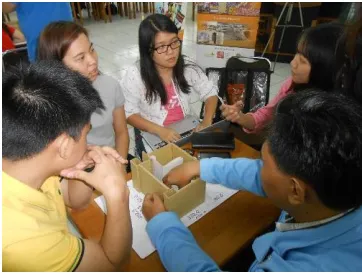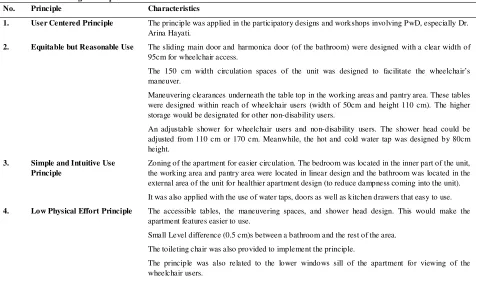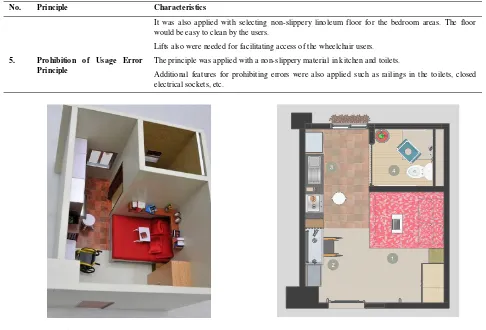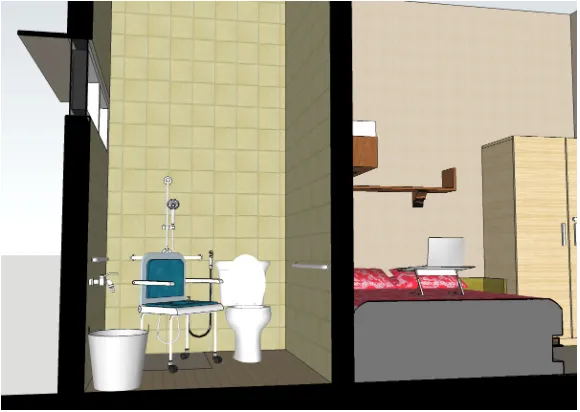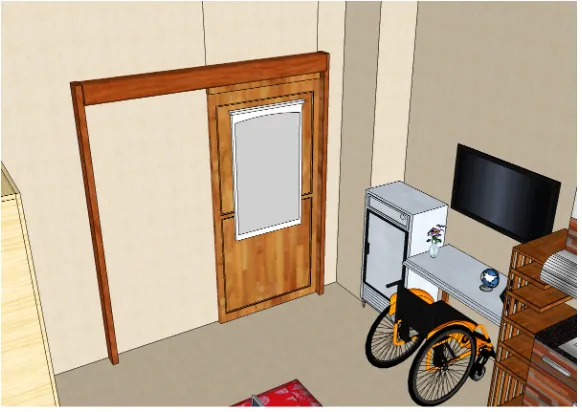Architecture Research and Design (AR+DC)
1-2 November 2016
The Low Cost Apartment for Wheelchair User
Gunawan Tanuwidjaja
a,*, Jocelin Marchelina
b, Valerie Layni Y
b, Joyie
b, Arina Hayati
c,
aArchitecture Program Study, Petra, Christian University, Jl. Siwalankerto 121-131 Surabaya, 60236, Indonesia, aStudents of Architecture Program Study, Petra, Christian University, Jl. Siwalankerto 121-131 Surabaya, 60236, Indonesia,
bDepartment of Architecture, Tenth November Institute of Technology, Kampus ITS Sukolilo, 60111, Surabaya,
*Corresponding author E-mail address:gunte@petra.ac.id
Abstract
The low-cost apartment concept was prescribed by Government to supply residential needs. The persons with disability (PwD), constituting 0.74% of Indonesian in 2000, (BPS, 2001)1 also needed the housing provision. In Surabaya, approximately five
thousand (5000) PwD were documented in 2010 or 0.1% from total population (BPS Surabaya).2Therefore, the accessible
low-cost apartment concept was needed for the provision. The 36-sqm-apartment design would cater person with a disability (a wheelchair user) and spouse were designed with five principles of inclusive design of Tanuwidjaja (2015).3 The design was
conducted with the participatory design process and several workshops with many users spectrum (wheelchair users, blind and deaf persons). The principles implemented in the design were: User-Centered, Equitable Use but Reasonable Use, Simple and Intuitive Use, Low Physical Effort, and Prohibition of Usage Error. The five principles were implemented inaccessible doors, reachable spaces, and furniture, as well as accessible toilets. All these ensures that the apartment unit to become accessible.
Keywords: Accessibility; Apartment Design; Inclusive Design; Principle; Wheelchair
1. Introduction of the subject
The Government and Developers have been pursuing the fast-paced development in residential provision with the low-cost apartment concept. On the other hand, the persons with disability (PwD), constituting of 1.46 million people in Indonesia (or 0.74% of 197 million populations) (Indonesia Statistics Agency/ BPS, 2001)4 needed the
proper and accessible housings. In Surabaya, approximately five thousand (5,000) PwD were documented in 2010 or 0.1% from total population (BPS Surabaya).5 The PwD population needed attention for the accessible issue in
housing. Therefore, the accessible low-cost apartment concept was needed for the provision. The 36-sqm-apartment initially were designed to cater a wheelchair user and spouse. But, later the apartment design was also acceptable for other users’ spectrum (blind and deaf persons). Therefore, the apartment was found inclusive for spectrum (wheelchair users, blind and deaf persons).
The accessibility issue could be answered with Inclusive Design method. The inclusive design was designed method that facilitates as many as possible users with consideration of their needs, safety as well as easiness. The process facilitated the minority society, disabled people, the elderly and children, received less attention in the common design process. On the other hand, Furthermore, the Nations Convention on the Rights of Persons with Disabilities, 2008 improved the understanding of disability as human rights and stated development priority for PwD, especially for housing. (Hartley, et.al. 2011).6
2. Interview and photo documentation of the PwD 3. Preliminary Design
4. Participatory workshop with Dr. Arina 5. Finalization of Preliminary Design
6. Participatory workshop with another person with disabilities in Surabaya and Bandung.
Literature reviews were conducted to understand the standards for accessible homes for PwD especially related to the PwDs with wheelchairs and crutches. Besides the standards, students were assigned to explore the PwD disability as well as potential. The students simulated as the PwD using wheelchair and crutch. With this simulation, students’ knowledge and awareness were improved. Interviews and photos documentation of the PwD were conducted to gather information on PwD and their homes.
The apartment preliminary design was prepared initially by the students in discussion with lecturers. To ensure the inclusiveness, the participatory workshop was conducted with Dr. Arina as the future user of the apartment. Incorporating the input from Dr. Arina, the design was later developed. And to create more universal apartment design, additional 2 workshops were conducted with the wheelchair users, blind persons, and deaf persons. The workshops were conducted with the architectural model to explain the apartment design to the PwD. The model was developed with a scale of 1:20 to be easily understood by the participants of the workshops.
To increase the public awareness of the universal design, the exhibition of apartment design was conducted in Grand City Mall and Library@Petra (Petra Christian University Library). Additional designs of homes and school were also included in the exhibitions. Social Campaign was also conducted concurrently with the exhibitions.
Fig. 3. Second Workshop Activity with wheelchair users in Bandung Fig. 4. Second Workshop Activity with deaf person in Bandung
3. Result and discussion
The apartment program was initially adopted from the normal studio apartment sold in Surabaya. The apartment was adjusted for the tropical climate with rezoning the toilets to the external part of the unit. The apartment program catered of working, sleeping, bathing, eating and simple food preparations. The apartment is designed as simple as possible and adjusted with height and range of wheelchair users. The studio room contains a bedroom, working area, bathroom, and pantry area.
The apartment were designed with Five Inclusive Design Principle as design principle as discussed as follow:
Table 1 Inclusive Design Principle
No. Principle Characteristics
1. User Centered Principle The principle was applied in the participatory designs and workshops involving PwD, especially Dr. Arina Hayati.
2. Equitable but Reasonable Use The sliding main door and harmonica door (of the bathroom) were designed with a clear width of 95cm for wheelchair access.
The 150 cm width circulation spaces of the unit was designed to facilitate the wheelchair’s maneuver.
Maneuvering clearances underneath the table top in the working areas and pantry area. These tables were designed within reach of wheelchair users (width of 50cm and height 110 cm). The higher
Zoning of the apartment for easier circulation. The bedroom was located in the inner part of the unit, the working area and pantry area were located in linear design and the bathroom was located in the external area of the unit for healthier apartment design (to reduce dampness coming into the unit). It was also applied with the use of water taps, doors as well as kitchen drawers that easy to use.
4. Low Physical Effort Principle The accessible tables, the maneuvering spaces, and shower head design. This would make the apartment features easier to use.
Small Level difference (0.5 cm)s between a bathroom and the rest of the area. The toileting chair was also provided to implement the principle.
Fig. 5. Architectural Model of the Apartment Fig. 6. Apartment Floor Plan. Info: (1) bedroom; (2) working area; (3) pantry area; (4) bathroom
Fig. 8. The bedroom that facilitate sleeping, reading also storing clothes. The harmonica door of the bathroom was also documented.
Fig. 10. The sliding door and working area.
Beside the design input above additional features could be added for facilitating other PwDs. The blind (total and low vision) persons needed an additional guiding path for non-sharp edges (walls, tops, and tables), the apartment corridors, the apartment lifts with sound identification for the floor, the water tub and shovel option for bathing, the braille signs on the doors, tables and cupboards doors.
Meanwhile, the deaf persons needed special lamps installed on top of the door frame. The lamps would be connected with doorbell, fire alarm, the cooking utensils or other applications that create safety alarm. The alarms sound should be translated into different lights color. Besides that, the deaf person needed a rounded table and seating for easier sign language communication. Glass doors could be implemented in the interior of the apartment or houses for easier sign language communication. Visual signage was also needed to facilitate wayfinding in the apartment’s blocks. So additional text telephone should be installed inside of the lifts.
4. Conclusion
(Surabaya Riverside Villages’ People Association) and Institute Technology Bandung (ITB), School of Architecture, Planning and Policy Making, Department of Architecture.
Special thanks were given to Dr. Arina Hayati from ITS, Mr. Ahmad Fauzi M.Hum., Mrs, Lilik Ghoniyah Sofyan M.Ed., Mr. Abdul Syakur S.E., Ms. Paulina Mayasari S.Sn., Mr. Tutus Setiawan S.Pd. and Mrs. Desy S.Pd., Mr. Warsito, Mr. Gatot Subroto, and Mr. Hariyono Karno as the valuable resources persons.
References
Reports:
Badan Pusat Statistik Indonesia, (2001). Survey Sosial dan Ekonomi Nasional 2001, [in english translation: Indonesian Statistic Centre Bureau, (2001). National Social and Economic Survey 2001, Jakarta]
BPS Surabaya, Surabaya Dalam Angka 2014 (to be checked and translated)
Hartley, S., Ilagan, V., Madden, R., O fficer, A., Posarac, A., Seelman, K., Shakespeare, T., Sipos, S., Swanson, M., Thomas, M., & Q iu. Z., ed. (2011), World Report on Disability 2011. World Health Organization.
Mace, Ron, (1998), Universal Design: Housing for the Lifespan of all People, Department of Housing and Urban Development, U.S.
Pemerintah Republik Indonesia, (1997), Undang-Undang Nomor 4 Tahun 1997. [in english translation: Government of Republic of Indonesia (1997), The Act of no 4, Year 1997]
Pemerintah Republik Indonesia, (1998), Peraturan Pemerintah Nomor 43 Tahun 1998. [in english translation: Government of Republic of Indonesia (1998), The Government Regulation no 43, Year 1998]
Tanuwidjaja, G., Laurens, J. M., Sulendra, I. G. N., Erandaru, (2016). Service Learning of Inclusive Design for Homes and Schools in Surabaya and Bandung: Participatory Design and Campaign. Petra Christian University, (unpublished), Surabaya.
• One-half inch maximum rise at entrances thresholds to reduce tripping hazards. Dollies and hand trucks move over easily.
• Minimum 5’ x 5’ clear space inside and outside entry door. (Can be smaller in automatic power door provided). It allows for maneuvering while opening or closing door.
• Weather shields (a terrace, awning, long roof overhang, and/or carport) provide sheltered space for people while unlocking the door, waiting for a carpool, etc. It minimizes weather damage to door finish.
• Windows in doors and/or windows nearby to allow the residents (including children and wheelchair users) identifying the people outside the door (e.g. guests) before opening it.
• The lighted doorbell at the reachable height, intercom with portable telephone link, and/or wired intercom to enable visitors to communicate with residents.
• Light outside entry door and motion detector controlled lights to add general illumination, sense of security and eliminate dark approaches to the home.
• House numbers should be large, high contrast, located in a prominent place to make it easy for friends or emergency personnel to locate the residence.
2. Interior Circulation, with characteristics of:
• An open design that minimizes hallways and doorways and maximizes sight lines.
• At least one bedroom and accessible bathroom should be located on an accessible ground floor (same level as kitchen, living room, etc).
• Clear door opening width (32” minimum, 34”-36” wide door) for all doorways to improve circulation especially with many visitors like at parties and to reduce damage to door jambs when moving large furniture or appliances, equipment, ladders.
• Circulation route 42” minimum width and turning space in all rooms with 5’ diameter provides maneuvering room in the hallways and archways.
3. Vertical Circulation
• All stairs should have appropriate width and have space at the bottom for later installation of a platform lift, if needed to ensure convenient access between floors
If a two-story dwelling:
• At least one set of stacked closets, pantries, or storage spaces.
• A residential elevator with minimum 3’x 4’ clear floor area installed at the time of initial construction. This elevator serves as a shaft for later elevator installation- at a great cost saving.
• Stair handrails to extend horizontally beyond top and bottom risers. Steady users at top and bottom of stairs.
5. Bathroom
• Clear space 3’ in front and to one side of the toilet to allow easy maneuvering to and around toilet.
• Grab bars should not be stainless steel or chrome and use colors to match the decoration. Grab bars make it easier and safer for everyone to get in and out of the tub or shower and also function as towel bars.
• Long mirrors should be placed at bottom no more than 36” above the floor and top at least 72” high so that children and seated people can use mirror while at sink. It reduces water damage to wall finish behind sink and makes the room more spacious.
• Adjustable height, movable hand-held shower-head or 60”-72” flexible hose allows easy use by people of all height. It can be adjusted to the height of each user and help avoid wetting hairstyle, bandages, casts.
6. Switches and Controls
• Light switches 44”-48” high, and thermostats 48” maximum height. It will be reachable with hands full (e.g with elbow) and more accessible to children.
• Electrical outlets at beds and desks, each side for computer, electronic devices, and personal use equipment. • Electric outlets, 18” minimum height. It is easier to reach without bending and from seated position and users
are less likely to unplug appliances by pulling on the cord. 7. Windows
